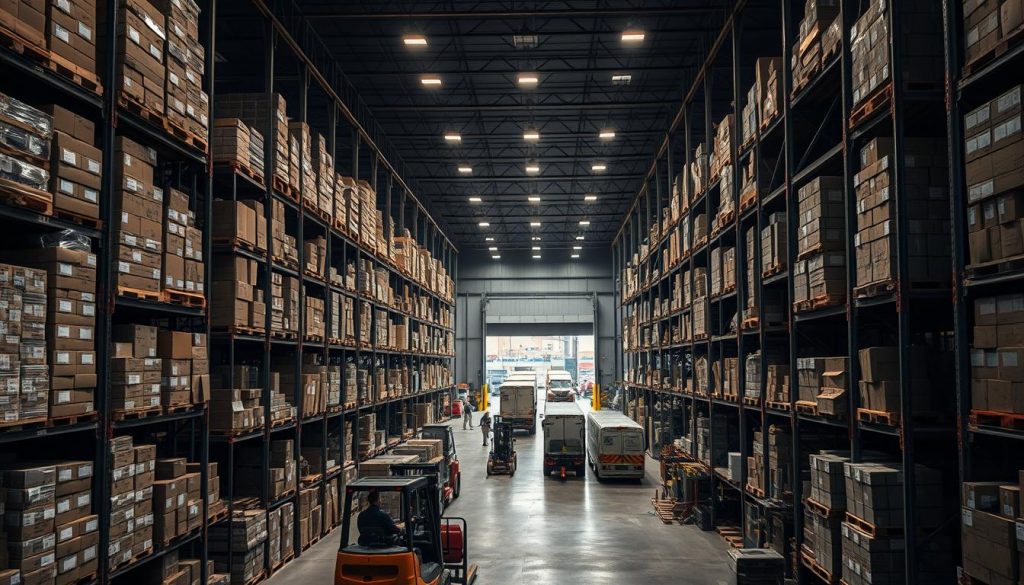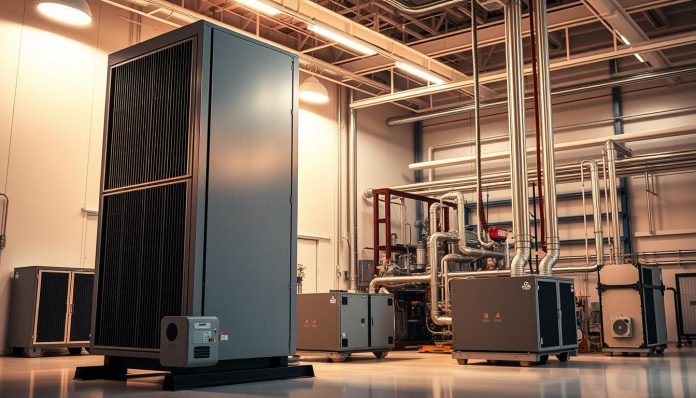Nearly one-fifth of UK power outages affect critical services each year, so resilient, zero‑emission options are rising up the agenda.
The guide introduces a sustainable technology shaping Britain’s future of energy. It explains how a fuel stack produces electricity through an electrochemical reaction that combines hydrogen and oxygen to make electricity, heat, and water.
These systems run quietly and reliably because they have no moving parts. They scale from kilowatt backup for hospitals and data hubs to multi‑megawatt installations for the grid.
In the UK context, pairing with offshore wind and growing solar capacity offers routes to store renewable output and deliver reliable power when required.
Readers will gain a clear roadmap: how the technology works, where it fits in the sustainable technology landscape, and the key terms — including stack, electrolyser, and CHP — used throughout this guide.
Key Takeaways
- These systems generate continuous, low‑carbon power at the point of use, emitting only water and heat.
- They are quiet and reliable due to minimal mechanical wear and simple operation.
- Scalable designs suit sites from buildings to grid‑level installations.
- Coupling with UK renewables supports energy storage and net zero ambitions.
- Advances in membranes, catalysts, and controls are reducing costs and improving performance.
The UK’s technology innovation landscape: hydrogen, sustainability, and zero‑emission power
A surge in British tech reporting now places low‑carbon solutions at the heart of national energy debates, reflecting the ongoing uk technology innovation. This shift reflects policy aims, investor interest, and industry momentum toward cleaner, more resilient systems.
Electrolysers and PEM advances are often highlighted for producing high‑purity hydrogen that responds quickly to fluctuating renewable output from wind and solar. That rapid response helps balance the grid and reduce reliance on gas during peak demand.
Industry and public sector leaders increasingly adopt these quiet, reliable generator options for hospitals, data centres, and critical sites. At the point of use, they deliver low-to-zero-emissions operation and contribute significantly to zero-emission power, helping cut urban air pollution and carbon footprints.
“Rapid advances in electrolysers and related stacks are changing how Britain plans long‑duration resilience,”
Pilot gas infrastructure and early deployments inform standards, safety, and permitting pathways. Policy incentives and regional strategies continue to steer early markets, while technology articles track investor interest and growing demand for flexible clean power.
- Supports grid balancing and peak‑load management.
- Complements batteries for longer‑duration resilience.
- Informs standards through real‑world generator trials.
What Are Hydrogen Fuel Cell Generators?
This part explains the difference between systems that make gas and those that use it for power.
Generator versus electrolyser: clarifying terms in the hydrogen ecosystem
A generator in this context is a power unit that converts hydrogen and air into electricity, heat, and water through an electrochemical process.
An electrolyser (often called a hydrogen generator) does the opposite: it splits water to produce high‑purity hydrogen gas for later use.
Core components: anode, cathode, catalyst, and the electrolyte membrane
The main parts are the anode and cathode flow fields, a thin electrolyte membrane, and a catalyst layer. A platinum catalyst is common in PEM types.
From hydrogen and air to electricity, heat, and water
The process called electrochemical conversion works like this:
- Hydrogen reaches the anode and is split by the catalyst into protons and electrons.
- Protons pass through the membrane while electrons travel via an external circuit to provide power.
- At the cathode, protons, electrons, and oxygen form water and release heat.
Purity and safety matter: electrolysers deliver gas at high purity to protect the stack. Oxygen from electrolysis is vented, and systems include leak detection and automatic shutdown.
| Component | Role | Typical tech |
|---|---|---|
| Anode | The site where hydrogen is split into protons and electrons | Flow field with a catalyst |
| Membrane | Conveys protons, isolates electrons | Proton exchange membrane (PEM) |
| Cathode | Combines protons, electrons, and oxygen to make water and heat | Air intake with a catalyst |
| Safety systems | Leak detection and automatic shutdown | Integrated sensors and control |
How Hydrogen Fuel Cells Work
Electrochemical conversion combines careful gas management, catalysts, and membranes to produce on‑site power and warmth.
Basic pathway: reactant gas enters the anode, where a catalyst splits it into protons and electrons. Protons cross a polymer membrane while electrons flow through an external circuit to deliver electricity.
At the cathode, those protons meet oxygen from the air and the electrons, forming water and releasing heat. This route keeps moving charges and avoids combustion, so systems run quietly.
PEM fundamentals
PEM types run at low temperatures (about 80–200°F). They start fast and follow load changes well, making them suitable for telecoms, vehicles, and scalable stationary installs in the UK, showcasing the advancements in hydrogen technology.
High‑temperature options
SOFCs and MCFCs operate at very high temperatures and often reform natural gas internally. They reach higher electrical efficiency and, in CHP mode, deliver total efficiencies above 70% — useful for buildings and industry.
Other types in context
PAFC suits cogeneration at hospitals and campuses. AFCs work in controlled environments. DMFCs use methanol for portable or backup power. Air supply, water management, and balance‑of‑plant design determine durability and real‑world efficiencies.
Hydrogen production today: electrolysers powering green hydrogen in the UK
Electrolysis turns surplus renewables into storable, dispatchable gas. On‑site units allow wind and solar farms to produce a supply close to demand, cutting logistics and improving system resilience.
PEM electrolysis: rapid response, high-purity hydrogen for clean energy
PEM systems use a solid polymer membrane and platinum catalysts to split water into hydrogen and oxygen at the electrodes.
They deliver up to 99.9995% purity gas on demand and respond quickly to variable renewables. The membrane separates ions while electrons travel through an external circuit, linking micro reactions to a usable supply.
Alkaline electrolysis: proven, durable, and cost‑effective at scale
Alkaline units use a potassium hydroxide electrolyte. They are durable and offer a lower capital cost for large production plants.
These systems suit industrial hubs and ports where steady, high‑volume output and low cost per kg matter most.
Solid oxide electrolysis: high‑efficiency using heat integration
Solid oxide electrolysers run at high temperatures (about 700–1000°C). They can reuse waste heat from industry to raise round‑trip efficiency.
Durability and materials remain challenges, but the efficiency gains can be significant where heat integration is possible.
Safety, purity, and on‑demand supply: lessons from laboratory hydrogen generators
“Lab systems show that continuous leak checks, automatic shutdown, and very low internal gas volumes greatly reduce risk.”
Typical lab units hold under 0.3 L of gas and limit pressures to ~120 psi. Reaching the 4.1% lower explosive limit is unlikely in normal operation.
| Technology | Key trait | Best fit |
|---|---|---|
| PEM | Fast response, high purity (99.9995%) | On‑site, flexible supply paired with wind/solar |
| Alkaline | Proven, lower capital cost | Large‑scale industrial production |
| Solid oxide | High efficiency with heat integration | Industrial clusters with waste heat |
Applications of Hydrogen Fuel Cell Generators
Practical deployments show these systems excel where reliability, low emissions, and sustainable energy technology are essential.
Backup power and resilience: Hospitals, data centres, and utilities benefit from quiet, fast‑starting backup units that keep critical loads online during outages. Units are sized by duty cycle and runtime, with service contracts that ensure high uptime and scheduled maintenance.
Transport and logistics
Buses, trucks, trains, and material‑handling vehicles use rapid refuelling and steady output to meet demanding schedules. Fleets find operational advantage in a consistent range and quick turnaround compared with batteries for some routes.
Primary power and CHP for buildings
Combined heat and power installations cut bills and carbon by using both electricity and waste heat. Industrial sites and campuses deploy these systems for baseload support and peak shaving within microgrids.
Laboratory and manufacturing uses
On‑site hydrogen generators supply high‑purity gas that reduces cylinder handling and downtime. Purity, pressure, and delivery protocols vary by application and drive the choice of storage and purification subsystems.
- Design note: sizing, gas quality, and service model must match regulatory and operational needs in the UK.
For a broader list of practical deployments and use cases, see this applications overview.
Market Growth and Technology Industry Insights in the UK
UK investment and policy shifts are accelerating commercial deployment across multiple clean energy niches, as highlighted in recent technology news uk. Support from public funds and corporate net-zero targets is creating clearer routes to project finance and procurement.

Policy drivers, investment flows, and sustainability targets
Government strategies and grant schemes aim to meet carbon budgets and improve security of supply, reflecting key technology industry insights. This policy pull helps lower perceived risks for investors and lenders.
Capital is flowing into pilot projects, manufacturing lines, and cluster development. That flow improves bankability as operational data and service networks mature.
Integration with renewables and grid services
Modular systems pair with wind and solar to offer frequency response, black‑start capability, and resilience for critical sites. PEM stacks respond quickly to intermittent generation, while solid oxide types promise higher efficiency where heat recovery is viable.
- Manufacturing: material innovation for catalysts and membranes, and standardised module designs reduce costs.
- Applications: campuses, ports, and utility projects benefit from digital controls that improve efficiency and economics.
- Infrastructure: refuelling corridors and cluster production align with regional plans and market demand.
Advantages of Hydrogen Fuel Cell Generators
Point‑of‑use electrochemical power provides both emissions reductions and resilient supply for critical services, as highlighted in various technology articles. These systems produce electricity, heat, and water at the point of use, so local pollutants fall and air quality improves in urban areas.
Low to zero emissions and reduced carbon footprint
Pure gas fed to stacks yields near‑zero on‑site emissions. That cut in local pollutants helps hospitals and city buildings meet sustainability targets and reduces a site’s overall carbon footprint.
High electrical efficiency and CHP potential
Electrical efficiencies typically range from about 40–60% for PEM types and 50–60% for high‑temperature designs.
When waste heat is captured in CHP mode, total efficiencies rise to 70–80%, lowering operating costs for campuses and industrial sites.
Reliability, scalability, and quiet operation
These systems run silently and need little mechanical maintenance because they have few moving parts. Modular designs scale from kilowatt‑class units to megawatt arrays, so they suit small clinics as well as large campuses.
- Continuous power: maintain electricity during outages for critical loads.
- Compact footprint: siting near buildings avoids long distribution runs.
- Lifecycle predictability: high‑purity gas and stable stack conditions reduce degradation.
| Advantage | Typical impact | UK use case |
|---|---|---|
| Low on‑site emissions | Improved urban air quality | Hospitals, schools |
| High total efficiency | Lower energy cost with CHP | University campuses, industry |
| Quiet, modular operation | Flexible siting near sensitive loads | Data centres, residential areas |
Challenges and Barriers to Adoption
Adoption faces a mix of technical and commercial barriers that must be tackled for wider roll‑out across the UK.

Costs, materials, and manufacturing scale‑up
Up‑front and lifecycle costs influence procurement and project viability. Stack materials, membrane‑electrode assemblies, and balance‑of‑plant add to the initial cost and operating budget.
PEM types rely on a platinum catalyst, which raises material expense. Scaling manufacturing reduces unit cost, but lead times and precious metal supply remain constraints.
Standards, safety, and permitting
Regulation and site conditions shape permitting timelines. Developers must build safety cases that align with electrical and gas rules in the UK.
“Lab units show that low internal gas volumes, continuous leak checks, and automatic shutdowns greatly reduce risk.”
Hydrogen’s lower explosive limit is 4.1%, so accidental large releases are the main hazard. Modern systems use layered detection and shutdown to manage this risk.
Supply, storage, and distribution constraints
Transporting gas and finding secure storage adds complexity and cost. On‑site generation can lower transport exposure and improve local supply certainty.
High temperatures pose durability challenges for some technologies, so robust thermal management and planned maintenance are essential to meet uptime for critical UK sites.
| Barrier | Impact | Mitigation |
|---|---|---|
| Material costs | Higher capex | Scale manufacturing, recycle catalysts |
| Permitting | Longer deployment time | Standardised designs, clear safety cases |
| Storage & logistics | Supply risk | On‑site generation, regional hubs |
Hydrogen Fuel Cell Generators: What You Need To Know
Practical procurement focuses on matching system specs to site loads, safety needs, and long‑term operating budgets. Buyers in the UK should translate technical ratings into a clear brief before tendering.
Purity, pressure, and sizing
Gas quality matters for stack life. Lab‑grade hydrogen generators deliver up to 99.9995% purity, outlet pressures near 120 psi, and very low internal volumes.
Size the generator and any storage by peak flow, pressure needs, and expected runtime during outages. Aim for a runtime that covers typical outage profiles rather than just short tests.
Maintenance, costs, and delivery
Check routine service intervals, remote monitoring, and spare parts lead time. Good maintenance reduces downtime and often lowers whole‑life costs.
- Costs: consider capex, opex (gas supply versus cylinders), spares and warranties — on‑site gas can pay back cylinders in 9–15 months.
- Types: PEM suits fast‑start backup and mobility; SOFC/MCFC suit CHP‑led building use; alkaline is lower‑cost at scale for production.
- Safety and approvals: require continuous leak checks, automatic shutdown, and UK compliance for faster permitting.
Delivery, training, and stakeholder engagement
Allow realistic delivery and commissioning time, include staff training in contracts, and engage grid and planning stakeholders early to smooth integration of power and thermal outputs.
The Role of Green Hydrogen in the UK Energy Mix
Electrolysers convert surplus wind and solar into storable gas that can later generate electricity, heat, and water with near‑zero local emissions.
Linking electrolysis to renewables creates firm, dispatchable power. By storing intermittent output as gas, operators can generate electricity when demand rises and reduce grid stress.
Sector coupling stretches benefits across transport, heat, and industry. Green gas fuels heavy vehicles, supports industrial heat processes, and supplies CHP systems that cut a site’s carbon footprint.
Air and oxygen management, plus careful water handling, matter for reliable production. Shared storage and modular generators at industrial clusters lower logistics and delivery costs.
Technology and outlook — advances in catalysts, modular designs, and high‑temperature electrolysis raise efficiencies and reduce lifecycle cost. Quiet, efficient fuel cell systems help decentralise power across grids and microgrids.
- Coupling with renewables provides firm, low‑carbon power.
- Sector coupling reduces the national carbon footprint.
- Standardisation and digital optimisation will scale production and cut costs through the 2020s.
| Benefit | Impact | UK use case |
|---|---|---|
| Stored gas | Dispatchable electricity | Grid support, hospitals |
| Sector coupling | Cross‑sector decarbonisation | Transport and industry |
| Modular design | Faster deployment | Industrial clusters |
Conclusion: Hydrogen Fuel Cell Generators: What You Need To Know
This closing note highlights practical steps for adopting clean, modular power in UK site conditions. It stresses matching a chosen system to local demand and safety needs before procurement.
Key takeaways: electrochemical units convert hydrogen and oxygen into electricity, heat, and water with low on‑site emissions. Efficiencies range from 40–60% electrically and can reach 70–80% in CHP mode.
Organisations should map load profiles, check gas purity and maintenance plans, and factor lifecycle costs — lab ROI versus cylinders can be under a year in some cases. The growing UK policy and finance ecosystem supports wider deployment of generators across many applications.
For a technical overview, see what is a hydrogen fuel cell, and plan projects that pair local renewables with modular systems to cut emissions and boost resilience.
For more articles on Energy, please follow the link.


